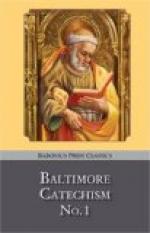117 Q. Who is the visible head of the Church? A. Our Holy Father the Pope, the Bishop of Rome, is the vicar of Christ on earth and the visible head of the Church.
The “Bishop of Rome” is always Pope. If the Bishop of New York, or of Baltimore, or of Boston, became Pope, he would become the Bishop of Rome and cease to be the Bishop of New York, Baltimore, or Boston, because St. Peter, the first Pope, was Bishop of Rome; and therefore only the bishops of Rome are his lawful successors—the true Popes—the true visible heads of the Church. The bishops of the other dioceses of the world are the lawful successors of the other Apostles who taught and established churches throughout the world. The bishops of the world are subject to the Pope, just as the other Apostles were subject to St. Peter, who was appointed their chief, by Our Lord Himself.
“Vicar”—that is, one who holds another’s place and acts in his name.
118 Q. Why is the Pope, the Bishop of Rome, the visible head of the Church? A. The Pope, the Bishop of Rome, is the visible head of the Church because he is the successor of St. Peter, whom Christ made the chief of the Apostles and the visible head of the Church.
“Of Rome.” That is why we are called Roman Catholics; to show that we are united to the real successor of St. Peter, and are therefore members of the true apostolic Church.
119 Q. Who are the successors of the other Apostles? A. The successors of the other Apostles are the bishops of the holy Catholic Church.
We know the Apostles were bishops, because they could make laws for the Church, consecrate other bishops, ordain priests, and give Confirmation—powers that belong only to bishops, and are still exercised by them.
120 Q. Why did Christ found the Church? A. Christ founded the Church to teach, govern, sanctify, and save all men.
“Teach” religion. “Govern” in things that regard salvation. “Sanctify,” make good. “Save” all who wish to be saved.
121 Q. Are all bound to belong to the Church? A. All are bound to belong to the Church, and he who knows the Church to be the true Church and remains out of it, cannot be saved.
Anyone who knows the Catholic religion to be the true religion and will not embrace it cannot enter into Heaven. If one not a Catholic doubts whether the church to which he belongs is the true Church, he must settle his doubt, seek the true Church, and enter it; for if he continues to live in doubt, he becomes like the one who knows the true Church and is deterred by worldly considerations from entering it.
In like manner one who, doubting, fears to examine the religion he professes lest he should discover its falsity and be convinced of the truth of the Catholic faith, cannot be saved.
Suppose, however, that there is a non-Catholic who firmly believes that the church to which he belongs is the true Church, and who has never—even in the past—had the slightest doubt of that fact—what will become of him?




